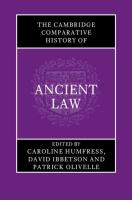
CUP (2024) h/b 706pp £150 (ISBN 9781009452243)
This substantial work of scholarship surveys the law of numerous civilisations across ancient India, the Near East, China, Greece and Rome. The editors and their team of eighteen contributors consciously break away from the traditional focus upon Western law, with its Graeco-Roman origins, as epitomised in Sir Henry Maine’s famous work on Ancient Law. They look at ancient law more broadly.
The book contains ten substantive chapters, each dedicated to a specific topic such as property, commerce or crime. There is also an introductory chapter to set the scene and a conclusions chapter at the end. This fairly rigid structure is beneficial, since a group of scholars from around the world are tackling a wide and amorphous subject-matter. The thematic approach adopted works much better than having one chapter on China, one on India, one on Rome and so forth.
Chapter 2, the first substantive chapter, is entitled ‘Law as text’. This takes us through the various surviving forms in which ancient laws have been written down. These include clay tablets in the Near East, inscriptions on metal vessels in China of the third to fourth centuries BC, carvings on stone, inscriptions on wood, papyri and so forth. There is a photograph of the famous stele of Hammurabi found at Susa. The stele contains over 300 separate provisions. At the top is a carving of the god Shamash dictating his laws to Hammurabi, the king of Babylon. The laws may be made by a monarch, or emperor, or they may be the product of some recognised process, such as a citizens’ assembly. The authors distinguish between (a) disparate legal rules, (b) coherent codes such as the Tang Penal Code in China and (c) commentaries, such as the writings of Roman jurists or Jewish rabbis. They also note the relevance of ethical works, which identify, rather than create, norms of behaviour. Aristotle’s writings on ethics, principally Nicomachean Ethics and Eudemian Ethics, have this function. So do the Analects of Confucius.
Chapter 4 is entitled ‘Law, peace and interstate relations’. Much of this chapter is focused on customs, rather than law as we would think of it. However, as noted on pages 148-149, there were enforceable rules for the protection of foreign nationals, such as traders who were present on business. Alliances and treaties were a regular feature of the ancient world, for example the Delian League centred upon Athens. Treaties fixing disputed boundaries between states can be identified as far back as the middle of the third millennium BC, as noted on page 569.[1] Nevertheless, states had little compunction in resorting to war as an instrument of foreign policy. In China during the Spring and Autumn period (771-464 BC) the warrior aristocracy regarded warfare as a religious activity and a duty which they owed to their ancestors.
Chapter 6 on ‘Law and religion’ addresses a topic of perpetual relevance. Law and religion have long been intertwined. In the ancient world, the two concepts were not distinguished from each other as they are today. Some laws were believed to have been handed down by a god or gods, for example the Babylonian Code of Hammurabi or the first five books of the Old Testament. Religious rituals may legitimate the government of the day, as still happens in coronation services. State authorities in their turn protect the priests. Dispensing justice may be seen as a religious function, as in the stories of King David and King Solomon (pages 242-243).
Chapter 10 on ‘Property’ will be of much interest to land lawyers. The authors observe that the concept of property predates civilisation and may have its origins in the neolithic period. Ownership and inheritance formed the basis of all ancient legal regimes and undergirded economic performance. There was a basic distinction between private ownership by individuals or families and public property or property embedded in the state organisation. In the ancient Near East and Egypt, land was commonly controlled either by the ruler or by temple estates. Tenants were attached to the land and farmed it. In Egypt under the Ptolemies, persons attached to temples could hold, lease and sell the land by private contract. This is recorded in surviving family archives. Athens and some other Greek city states kept records of sales of land and contracts in public archives. These archives performed a similar function to the modern Land Registry. Ancient India developed principles of property ownership. Sanskrit scholastic texts said that the ruler had the responsibility to recognise and protect private property. As is well known, Roman law contained detailed provisions for property ownership and transfer.
The brief summaries set out above are no more than a sample of what the book has to offer. A full synopsis of this massive work is not possible within the confines of this review.
The book is not light reading. But it is rewarding. It has much to offer historians, because some form of law is a feature of every society; and it is helpful to review the legal systems of the ancient world holistically. The book also has much to offer those lawyers who look above the horizon and are interested in the evolution of law and in the origin of the legal principles which they apply in their daily work.
Rupert Jackson
[1] This passage on page 569 forms part of chapter 11 on ‘Commerce and contracts’, but it would fit more naturally in chapter 4 on ‘War, peace and interstate relations’.
